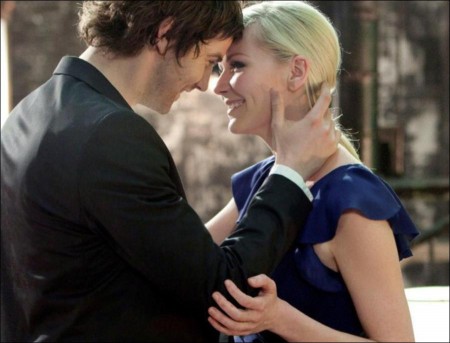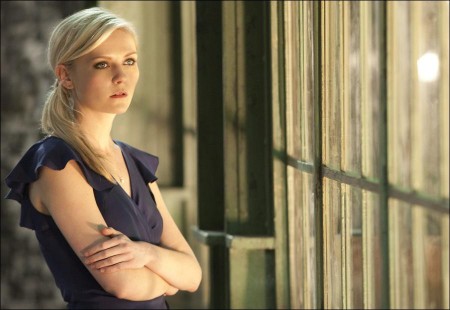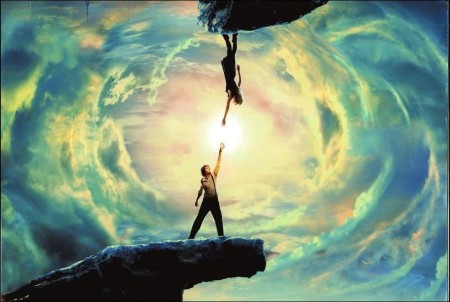Taglines: Two worlds. One future.
Ever since Adam (Jim Sturgess) and Eden (Kirsten Dunst) fell in love as teens, their bond has faced astronomical odds. The pair are separated not just by social class and a political system bent on keeping them apart, but also by a freak planetary condition: they live on twinned worlds with gravities that pull in opposite directions—he on the poverty-stricken planet below, she on the wealthy, exploitative world above.
Their budding but illicit romance screeches to a tragic halt when interplanetary-border patrol agents catch them and Eden suffers an apparently fatal fall. But when, ten years later, Adam learns she is alive and working at a vast corporation whose towering headquarters connects their planets, he sets out on a dangerous quest to infiltrate the company and the upper world to reconnect with her. UPSIDE DOWN is a visually stunning romantic adventure that poses the question: what if love was stronger than gravity?
Upside Down (French: Un monde à l’envers) is a Canadian-French romantic science fiction film written and directed by Juan Diego Solanas, starring Jim Sturgess and Kirsten Dunst.
About the Production (2013)
Upside Down began as a single image seen in a dream by writer-director Juan Solanas. “I saw this man on top of a mountain, looking up and seeing a woman on top of another mountain but upside down,” Solanas recalls of that seminal moment. “It left a strong impression on me.”
From that image, Solanas began teasing out a story line, and soon knew he had found his next movie project. Almost immediately, he started writing down his thoughts, with the image ultimately becoming the all-important meeting of two star-crossed lovers living on twinned worlds and separated by opposite gravities.
It’s not the first time Solanas, a former photographer and the son of renowned Argentine film director Fernando Solanas, has created a full-blown film from a single image. He took the same path for his surreal and evocative short, The Man Without a Head, which won a raft of prizes around the world, including the Jury Prize at the 2003 Cannes Film Festival, and was nominated for the Palme D’Or for Best Short. His award-winning 2005 feature film, Northeast, had a similar origin.
“Deep down, I’m a photographer so I am totally visual,” Solanas says. “It’s probably the result of an unconscious process. Once the image calls me, I look and I understand the story that comes with it. It’s been like that each time.”
Solanas took his dream-inspired ideas for Upside Down to his longtime collaborator, producer Aton Soumache (Renaissance), who had worked with him on The Man Without a Head. Soumache recalls being blown away by the richness of what Solanas presented to him.
“The world that he created with these two opposite planets was so incredible,” Soumache recalls. “We were so excited. We came up with thousands and thousands of ideas.”
The men worked on the script for more than two years, blending elements of classic love stories like “Romeo and Juliet” with fantastic flights of imagination to create a poetic fairytale that’s as original as it is arresting to the eye.
“Visually, I’ve never seen anything like this,” says the film’s female lead, Kirsten Dunst(Spider-Man,Melancholia). “There’s this whole idea of these parallel universes that connect, and there’s a political aspect to it, there’s a romance, and there’s a whole new era that’s created at the end of this film, as well. It’s got a lot of huge themes, but it’s done in a very funny, quirky way.”
The grand innovation of the concept is the twinned planets with their opposing gravitational fields. On the one hand, there is the impoverished, so-called “Down Below,” where people live in simple clothes with no money and no electricity. On the other hand, so close that it all but hides the sky, is thewealthy “Up Top,”which exploits the resources of the lower world but shares none of the benefits. Lovers Adam and Eden live on — and are separated by — these different worlds.
It’s a conceit that’s rich in metaphoric overtones that hint at more earthbound issues such as slavery, apartheid, environmental exploitation and interracial relationships, says the film’s male lead, Jim Sturgess (Cloud Atlas,Across the Universe).
“In any good love story there are always obstacles that prevent the couple from being together,” Sturgess says. “And in this case, gravity plays a huge part in that — the fact that these people don’t even exist in the same gravitational pull. It’s one of the biggest characters in the film really.”
As excited as he was about Solanas’ ideas, Soumache was initially unsure they could be made into a film. But Solanas, who is praised by cast and crew alike for his raw, creative energy, was insistent that it could be done if they could assemble an exceptionally talented crew. They did just that, recruiting A-list production designer Alex McDowell (Fight Club, Minority Report); visual effects supervisor Francois Dumoulin (Demonlover), who had also worked on The Man Without a Head; and cinematographer Pierre Gill (Outlander, The Art of War).
Soumache says having a production designer of McDowell’s caliber was essential to the making of the film. “We really needed somebody who was able to create a unique world,” the producer says. “There are not a lot of production designers who can do this kind of movie — maybe four or five in the world.”
McDowell loved the script and, after Solanas flew from Montreal to meet him in Los Angeles, signed on to the project quickly. “It was a highly seductive project so it actually went very fast,” McDowell says. “I’m always drawn to films that have a real personal kind of interior world that is being built — one that has real meaning to the director. This was something that was absolutely built from a vision Juan had, and so that in itself was very interesting. And then, of course, the idea is quite fantastic.”
McDowell says Solanas had spent a lot of time working out a “great interior logic” for the film. For example, the dual gravity is governed by three rules: First, all matter is pulled by the gravity of the world that it comes from, and not the other; second, an object’s weight can be offset by matter from the opposite world (aka inverse matter); and third, after some time, matter in contact with inverse matter burns. Solanas had also gathered mountains of photographs and pictorial material to work from.
“It’s an amazing design challenge to think about this idea of two worlds, somewhat parallel to our own, but with this proximity — and two gravities, and all the complexity that that involves,” McDowell says. “And the political and social undertones were really interesting to me. There was a real sense that he had a vision and knew what he wanted from it.”
Director of photography Pierre Gill, who signed onto the project after Solanas flew to meet him in Paris, also found the project irresistible.
“It’s like a dream come true for any filmmaker,” he says. “It’s unique. It’s very creative, very colorful, very amazing. When I went to Juan’s apartment, the first thing he showed me was the book with the visual references. The artwork was outstanding.”
As for Solanas himself, he quickly overcame any doubts that he would be up to the task of helming the multi-million-dollar project, which was a huge step up from his previous films. McDowell says he for one had complete confidence in Solanas’ ability, given his filmmaking pedigree and previous careers as a photographer and 20 years as a cinematographer.
“Juan is a great visionary,” McDowell says. “There’s no question that everybody signed on to this film because he had this totally original idea and vision driving everything.”
Upside Down (2013)
Directed by: Juan Diego Solanas
Starring: Kirsten Dunst, Jim Sturgess, Timothy Spall, Agnieshka Wnorowska, Jayne Heitmeyer
Screenplay by: Juan Diego Solanas
Production Design by: Alex McDowell
Cinematography by: Pierre Gill
Film Editing by: Paul Jutras
Costume Design by: Nicoletta Massone
Set Decoration by: Paul Hotte
Art Direction by: Isabelle Guay, Jean-Pierre Paquet
Music by: Benoît Charest
MPAA Rating: PG-13 for some violence.
Studio: Millennium Entertainment
Release Date: March 15, 2013
Visits: 162








